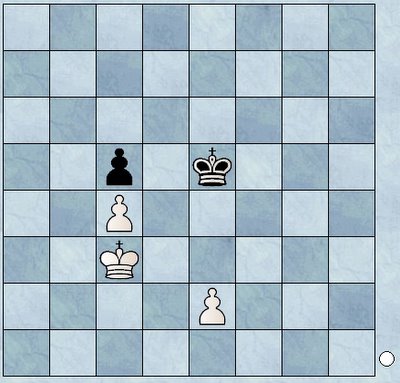My first win by a pawn ending!!
Today at the club I had black and played the Icelandic gambit.
My opponent declined and I could inflict him with an isolated queen pawn.
In stead of forcing matters, I just started to press on the weak pawn.
Every tactic I used led to the trading off of more pieces.
Playing open positions and the use of tactics is the fastest way to an endgame indeed!
There is another advantage of playing endgames.
The average length of my games is about 20-25 moves or so.
Playing an endgame with 60-75 moves means that my opponent has 3 x as much opportunity to make an error. So if there is a difference in strenght, the chance that this results in a point is 3 times higher. Very interesting!
I always felt that I accepted too much draws from weaker opponents.
In defending his IQP he made an error indeed which costed him a pawn.
The pawn ending was an easy win.
From an exercise in SOPE:

White to move and win.
Calculating long lines is just a matter of knowing the compounding short lines.
A few weeks ago, I could not solve this problem by mere calculation.
Today it was easy.
In order to win, white has to get the black pawn.
First I allready knew that there isn't enough space for the white king to go thru the middle.
Second I knew that it is possible to win the pawn by going along the right side of the board.
Third I knew if I did that, that black has a forced draw because he's left with a bishop's pawn at the 2nd rank against a white queen.
So the right method is going along the left side to conquer a key square (a5 or b5) of the black pawn and to sac your e-pawn.
The only calculation I had to do is that 1. Kb3 isn't good because of 1. ... Kd4
The theory of corresponding squares told me that 1. Kb2! is the winning move.
No way that I could find this in the past.
But after only a few weeks of studying pawn endings, it was actually quite simple!
My opponent declined and I could inflict him with an isolated queen pawn.
In stead of forcing matters, I just started to press on the weak pawn.
Every tactic I used led to the trading off of more pieces.
Playing open positions and the use of tactics is the fastest way to an endgame indeed!
There is another advantage of playing endgames.
The average length of my games is about 20-25 moves or so.
Playing an endgame with 60-75 moves means that my opponent has 3 x as much opportunity to make an error. So if there is a difference in strenght, the chance that this results in a point is 3 times higher. Very interesting!
I always felt that I accepted too much draws from weaker opponents.
In defending his IQP he made an error indeed which costed him a pawn.
The pawn ending was an easy win.
From an exercise in SOPE:

White to move and win.
Calculating long lines is just a matter of knowing the compounding short lines.
A few weeks ago, I could not solve this problem by mere calculation.
Today it was easy.
In order to win, white has to get the black pawn.
First I allready knew that there isn't enough space for the white king to go thru the middle.
Second I knew that it is possible to win the pawn by going along the right side of the board.
Third I knew if I did that, that black has a forced draw because he's left with a bishop's pawn at the 2nd rank against a white queen.
So the right method is going along the left side to conquer a key square (a5 or b5) of the black pawn and to sac your e-pawn.
The only calculation I had to do is that 1. Kb3 isn't good because of 1. ... Kd4
The theory of corresponding squares told me that 1. Kb2! is the winning move.
No way that I could find this in the past.
But after only a few weeks of studying pawn endings, it was actually quite simple!
Interesting. Is 1.Kb2 really only winning move?
ReplyDeleteI was thinking about line 1.Kb3 Kd4 2.e4! Kxe4 3.Ka4 white gives e-pawn to win c-pawn.
3...Kd4 4.Kb5 and white wins
3...Ke5 4.Kb5 Ke6 5.Kxc5 Kd7 6.Kb6 Kc8 7.Kc6 white wins
- bahus
>..it was actually quite simple!
ReplyDeleteAh, that's the way.
Bahus,
ReplyDeleteindeed, 1.Kb2! is the only move
1.Kb3? Kd4
2.e4 Kxe4
3.Ka4 Kd3!
4.Kb3 Ke3 =
4.Kb5?? Kd4 and black wins!
It is important to get a feeling for corresponding squares. With mere calculation it is simply not doable.